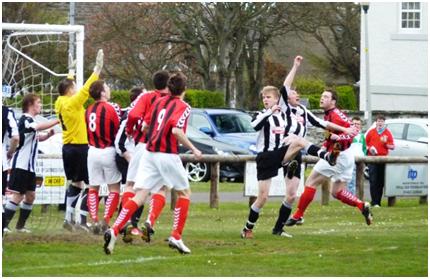Highland Odyssey Part 2.
After the lengthy travels of the previous day, getting from Inverurie to Banff was a short run on country roads. The 26 miles took about 40 minutes. Banff is a bigger town on the coast, and has a small but picturesque harbour. The prevailing grey stone is still the norm, so often covered with a very unattractive pebble dash finish. Still, the town is more impressive with a few grand buildings. There was no early morning bustle about the place though, and both the centre and the harbour side seemed very quiet.
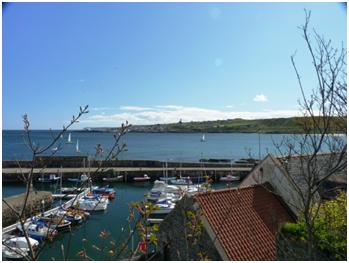
Banff is at the mouth of the river Deveron, and it is the river that gives the name to both the town’s football clubs. The Highland league club, Deveronvale was founded by a merger between two clubs, Banff Rovers and Deveron Valley in 1938. Their greatest successes though have been in recent years, with their only two League titles coming in 2003 and 2006, with a Qualifying Cup success in 2002. Arriving in the town from the south, and over the Deveron bridge, the ground is directly in front of me before I enter the town. It looks impressive with the main stand sitting up high. Indeed this is one of those higher stands, with around a ten foot drop below the lowest seats. The area in front of the stand is narrow, and is not open to the public, but both team benches are here. The stand incorporates the dressing rooms downstairs, and a boardroom and supporters ‘ club bar above. The bar is not well advertised and I only found it by chance while looking for team lists, (they readily found me one in said bar). Outside, spectators can stand on a concrete path only on the side with the stand, the other three sides of the ground have grass surrounds, with just a slight banking.
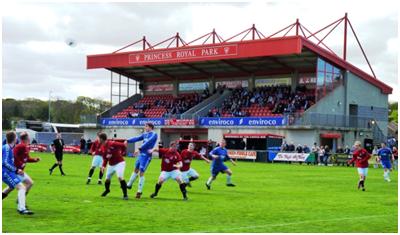
The match was between the teams placed fourth and second in the league, but visitors Cove knew that no result could move them either up or down from second position. The homesters could not drop a place, but rise up to third with a win a position they keep only if Fraserburgh lose to bottom club Rothes next week. The match had an end of season feel to it, played without a great deal of pace, but on a fine lush surface, ‘Vale were shown to be a good footballing side, with some fine passing moves finding spaces for players on both wings. A tendency to be caught offside, and poor finishing were more at fault for keeping the score down then and defensive abilities on the part of Cove. Steven Gauld put ‘Vale ahead just before the break, and then added a second with fifteen minutes to play. Two minutes later, Graeme Webb added a third to complete a surprisingly comprehensive scoreline. Cove were down to 10 players for the last 18 minutes after left winger Dean Lawrie went off injured.
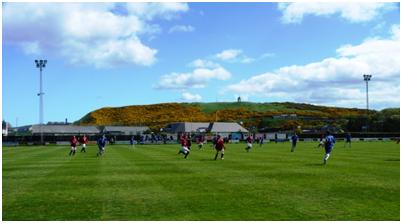
From Princess Royal Park, the walk to Canal Park, the home of Deveronside is quite easy. One exits the ground, turn right and wait until you are clear of the first ground. Canal Park is a railed off pitch, next to Princess Royal Park. There is a dressing room block well behind the goal, and this has a veranda area which provides a little cover if rather a distance behind the goal.
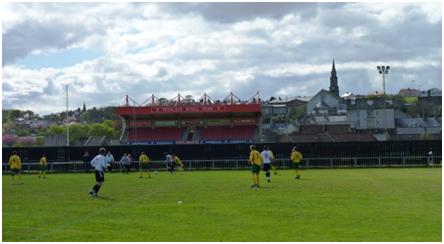
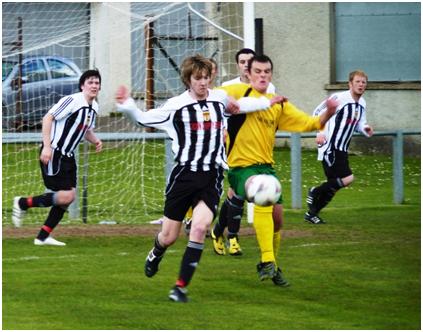
While the games in the Highland League were not over physical, this Junior match was a foul a minute, and after an initial spell of leniency, the referee sprinkled yellow cards around, but somehow managed to keep all 22 players on the field. This was something that did not happen in any of the Highland League games, with two red cards and a late injury to reduce the field. The visitors, Islavale defied their lowly league position and ran out comfortable 4-1 winners, both sides scoring a penalty, and the second goal for Islavale being an own goal, pictured below
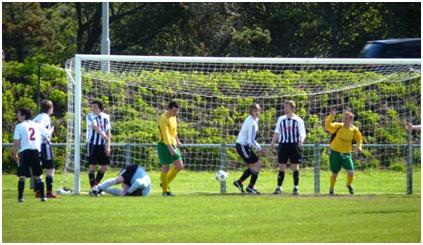
In the home side line up, one of the players had earlier came on as substitute for Deveronvale in the last five minutes of the earlier game. I had thought that there were rules about Junior players playing for Senior teams, resulting in the familiar name “A. Trialist”, on many Scottish League team sheets. It appears that the Junior FA has relaxed its rules, the wording now being “A player registered by a club in membership shall not take part in Senior games or matches unless he has the written consent of the Secretary or other official of the Junior club for which he is registered for each game”, which I take it as meaning that if the player concerned was a Deveronside player, he could play for Deveronvale with written permission for each game (he has been substitute on several other occasions), but as far as I know, players with Senior clubs still have to go through a re-registration process to rejoin the Juniors.
After the game, I drove two hours to Inverness, and in the morning a further two hours to Wick, to get to Wick, the most Northerly Senior club in Britain. Before this trip, I had only seen one Highland League game in over 20 years. That game was Inverness Thistle’s final game in the league, before the merged with rivals Caledonian to join the Scottish League. Although the Highland League had lost three clubs, two from Inverness and Ross County, only one replacement was elected. It was a brave decision by the clubs, as the new boys would have to travel just over 50 miles for the closest match, and over 100 miles for every other game. Wick were already known to the Highland League clubs as a Senior club and member of the Scottish FA, they playing in the Scottish Qualifying Cup. Second in the 1994 poll was Inverurie Loco Works, who eventually entered the league in 2002, transferring from the Junior game.
Prior to joining the Highland League, Wick had over 100 years of history, founded in 1893 and taking the same name as a local Cricket club. The Academy in question is Putteney Academy, and while there was never an official connection between club and school, a teacher from the Academy was elected as first club captain. Wick gained full membership of the Scottish FA in 1911, allowing them to play in the Qualifying Cup, The beat Inverness Thistle in their first ever Scottish Qualifying tie, but lost to Caledonian in the second. Through the 1920s and 30s, as the only SFA club in Caithness (excepting Thurso Pentland 1933-6), they were allowed to sign other local players for cup ties, and were virtually unbeatable at home in the cups for many years. The 1960s bought a problem when the local amateur FA switched to summer football. Wick had to remain a winter side in order to play their cup ties, but for 12 years they only played Friendly games and Cup ties. They then joined the Northern Reserve League, which as its name suggests was mainly for reserve teams. The league later became the North Caledonian League, and still runs with 10 teams. Thurso, (which is north of even Wick) are the current Champions, while Fort William are the only reserve team now in membership.
Harmsworth Park is easily found, as it is on the road as you enter Wick from the South, just as you come into town past the inevitable retail park. Visitors to this part of Scotland go for what lies between the towns, rather than the towns themselves, and Wick is no more inspirational than the other places visited on the trip. The trip up did take me past some quite dramatic coastlines, while out to see, one could pick out the outlines of oil rigs in the distance. The football ground is neat and tidy, with a small seated stand on one side and a much longer stand opposite. This is generally for standing, but there is a single row of seats at the back, many in a very poor state of repair. One assumes this is a remnant from some decision to increase the number of seats which was poorly carried out as anyone using them would have their views blocked by those standing further forward. From the main road entrance, there is a tarmac path providing a route to post areas of cover, but at the other end of the ground, the pitch barrier is surrounded only by grass. The pitch slopes up slightly, and above the top end, there is a gentle grass slope running back another twenty yards or so. Above this is a much steeper slope with a car park on a terrace at the top. There is a top entrance to the ground allowing access as there is no sign of this from the main road. I parked on the main road, along with the visitors coach, and some of the other spectators.
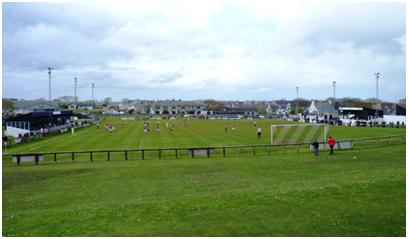
I was told by an Inverurie official that with the match kicking off at 1.30 in the afternoon, they had left at 6.30 in order to get here. I was surprised they had agreed to the unusual kick off time, but as it turned out, they had actually requested an early start, preferring this to a late finish when most of their players would have to work the next day. They had to abandon a plan to send mainly youth players up for this game, as Monday was the start of exams for those still at school, but still Inverurie managed to make five changes from the starting XI I had seen two days before, and added four further fresh faces on the bench. Wick has also played on the Friday night, losing 6-1 at Rothes, but made only two changes to the starting line up.

180 people attended the match, (I got to this figure with a head count, and found exactly the same figure on teletext in the evening), paying £6 to enter, and £1 extra if they wanted a programme. Using Leo’s theorem about equal levels of football producing equal attendances, this places the Highland League as a Scottish equivalent to a Step 3 League (Northern Premier, or Southern Premier) in England. This I feel, is about right. The English League’s would not accept the Highland League grounds on the basis of size of paved pathway or number of empty seats, but otherwise they are up to the standard. The football in the Highland League seems to be a more open passing game than the rough and tumble long ball and hope found in England but I would not bet on the Highland defences to cope with the constant barrage of high balls into the area, whereas for all the attractive passing moves, the finishing was often lacking here. The game at Wick was very open in the first half, with plenty of chances at both ends. Wick took the lead on 27 minutes, and Inverurie faded badly after this conceding a second goal nine minutes into the second half, and being under pressure for most of the rest of the game. The Locos goalkeeper received his marching orders with only two minutes left on the clock for a silly contretemps while waiting for corner to be taken. If you are going to kick out, wait until the referee is not looking. The replacement ‘keeper did not make a save, and rather surprisingly, Inverurie pulled the score back to 2-1 in injury time.
